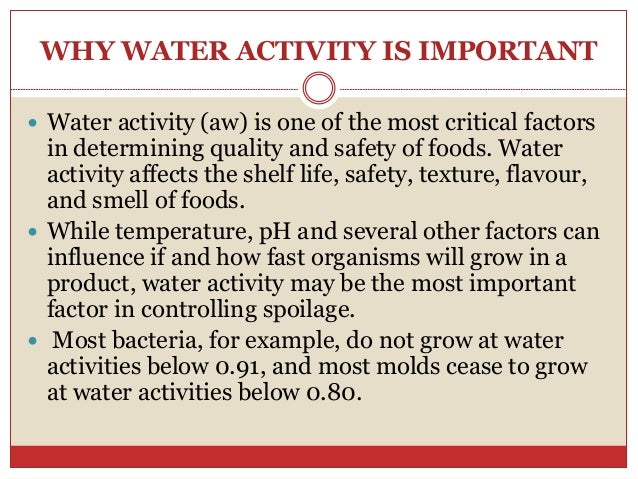

More importantly, Aw values of glycerol–water mixtures can be explained by the hydrogen bonding network and molecular dynamics of water in the solution. Translational diffusive and/or rotational motions in time and space analyzed by IQENS appeared when Aw > ≈ 0.7, and are correlated with hydrogen bonding related local vibrational dynamics in the glycerol–water mixtures. Hydrogen bonding related molecular vibrations were analyzed by ATR-IR, which indicated that the OH stretching in water molecules is significantly different for Aw > ≈ 0.7. DSC showed that bulk-like water existed at Aw > ≈ 0.7 at 27☌. Three regions were identified and classified based on DSC results. In this study, the molecular basis of Aw was examined by using differential scanning calorimetry (DSC), attenuated total reflection Fourier-transform infrared spectroscopy (ATR-IR), and incoherent quasi-elastic neutron scattering (IQENS) based on moisture sorption isotherms of glycerol–water mixtures. Glycerol–water mixtures can provide a variation of Aws by controlling the ratio of glycerol and water. However, a molecular basis of Aw is still under debate in multiple related disciplines. Water activity (Aw) is a reliable indication of the microbial growth, enzymatic activity, preservation, and quality of foods. 1Hierarchical Structure Research Group, Materials Science Research Center, Japan Atomic Energy Agency, Ibaraki, Japan.For example a commercial shelf life over twelve months might be required for confectionery in these circumstances an aw below 0.6 would be required. While this will not ensure complete freedom from microbial spoilage, those few yeasts and moulds which do grow at lower water activities need only to be considered when special shelf life conditions must be met. Most moulds cease to grow at a water activity level below about 0.8, but since some moulds will grow slowly at this aw, it is usually recommended that products of this type do not have an aw greater than 0.75. When these foods spoil, it is usually the result of surface mould growth. These foods can be described as semi-moist and include fruit cakes, puddings and sweet sauces such as chocolate and caramel.

However many foods can be successfully stored at room temperature by proper control of their water activity (a W). These include most fresh foods and many processed foods such as soft cheeses and cured meats. Semi-moist foodsįor foods with a relatively high water activity correct refrigeration is always necessary. Foods which may support the growth of this bacterium include cheese and fermented sausages stored above correct refrigeration temperatures. Staphylococcus aureus, a common food poisoning organism, can grow down to this relatively low water activity level. The risk of food poisoning must be considered in low acid foods (pH > 4.5) with a water activity greater than 0.86 aw.

We also know that Clostridium botulinum, the most dangerous food poisoning bacterium, is unable to grow at an aw of. For example we can see that food with a water activity below 0.6 will not support the growth of osmophilic yeasts. The diagram illustrates the water activity (a W) levels which can support the growth of particular groups of bacteria, yeasts and moulds. This can effectively increase the product's stability and make it possible to predict its shelf life under known ambient storage conditions.įood can be made safe to store by lowering the water activity to a point that will not allow dangerous pathogens such as Clostridium botulinum and Staphylococcus aureus to grow in it. Water activity (a W) has its most useful application in predicting the growth of bacteria, yeasts and moulds.įor a food to have a useful shelf life without relying on refrigerated storage, it is necessary to control either its acidity level (pH) or the level of water activity (a W) or a suitable combination of the two. Thus a food with a water activity (a W) of 0.7 would produce an ERH of 70%. If we multiply this ratio by 100, we obtain the equilibrium relative humidity (ERH) that the foodstuff would produce if enclosed with air in a sealed container at constant temperature. The water activity (a W) represents the ratio of the water vapour pressure of the food to the water vapour pressure of pure water under the same conditions and it is expressed as a fraction. Water activity is in practice usually measured as equilibrium relative humidity (ERH). The water activity scale extends from 0 (bone dry) to 1.0 (pure water) but most foods have a water activity level in the range of 0.2 for very dry foods to 0.99 for moist fresh foods.


 0 kommentar(er)
0 kommentar(er)
